Menu
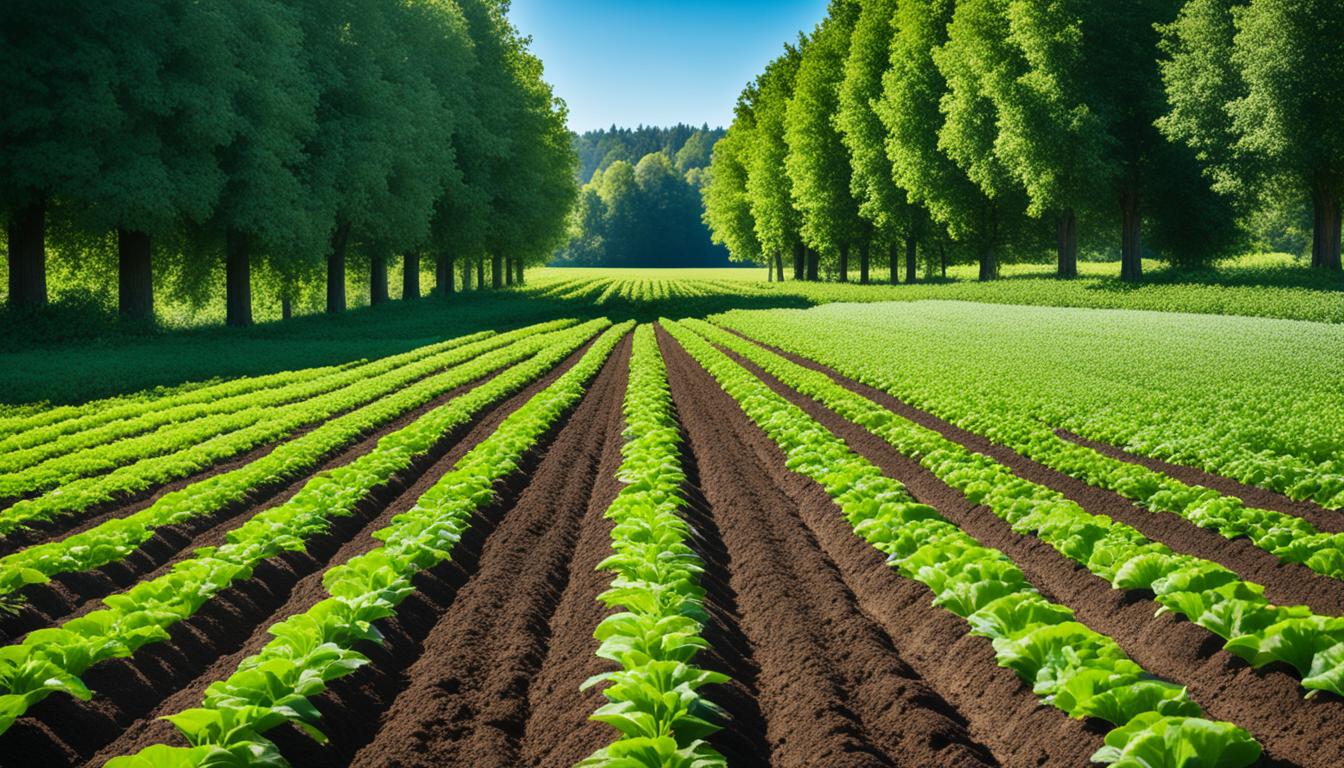
Agriculture creates about 11% of the EU’s greenhouse gas emissions. This amounts to roughly 400 million tonnes of CO2 each year. This makes it clear that we need serious changes in how we farm to protect the planet.
Carbon management is a vital part of sustainable farming. It focuses on capturing more CO2 in the farm’s green spaces. By running in step with regenerative agriculture ideals, it aims to improve soil health and boost farm yields. The Carbon Cycle Institute leads with a strong plan. It includes policies, technical support, and various partnerships. This strategy is key for capturing more carbon, improving nature’s services, making farms more resilient, and combating climate change.
Many carbon farming practices work to stash away carbon and cut down on greenhouse gases. These actions also bring extra benefits like better water conditions and more plant and animal life. So, they help both the climate and the wider farm ecosystem.
Carbon farming is a key part of fighting climate change. It involves farming methods that store carbon in the soil and plants. This helps cut down the carbon footprint of farming. It also shows how important sustainable farming is for the planet and our future.
To cut carbon footprints, we need to use farming methods that keep the soil and plants rich in carbon. This way, we can help reach the goal of no net greenhouse gases by 2050. These methods involve keeping the carbon stored for a long time, up to 100 years.
The world will need 56% more food by 2050. This means we must use clever ways to manage carbon in farming. One way is to keep the ground covered. This not only cuts greenhouse gases but also makes the land more varied. So, we can protect the environment and still make enough food.
Getting into carbon farming might need a lot of work. It includes things like managing plants and keeping out harmful species. Also, there are costs for checking and reporting how well the land stores carbon. But, these efforts can mean a steady income for farmers. They also help look after special areas and keep water clean.
In short, carbon farming helps us make more food without harming the planet. By using smart farming, we keep our land and atmosphere healthy. This is vital for a future where we emit no extra greenhouse gases by 2050.
Carbon farming is gaining fame in South Australia as a new industry. It helps with climate change and lets farmers focus on bettering the environment. Agricultural resilience becomes stronger thanks to this. It’s key as climate change endangers future farming.
This farming method boosts important ecosystem services like providing water and enhancing biodiversity. Better farm productivity and sustainability show why teaching climate and carbon cycle skills to farmers is crucial. They can then use smart farming techniques to combat climate change.
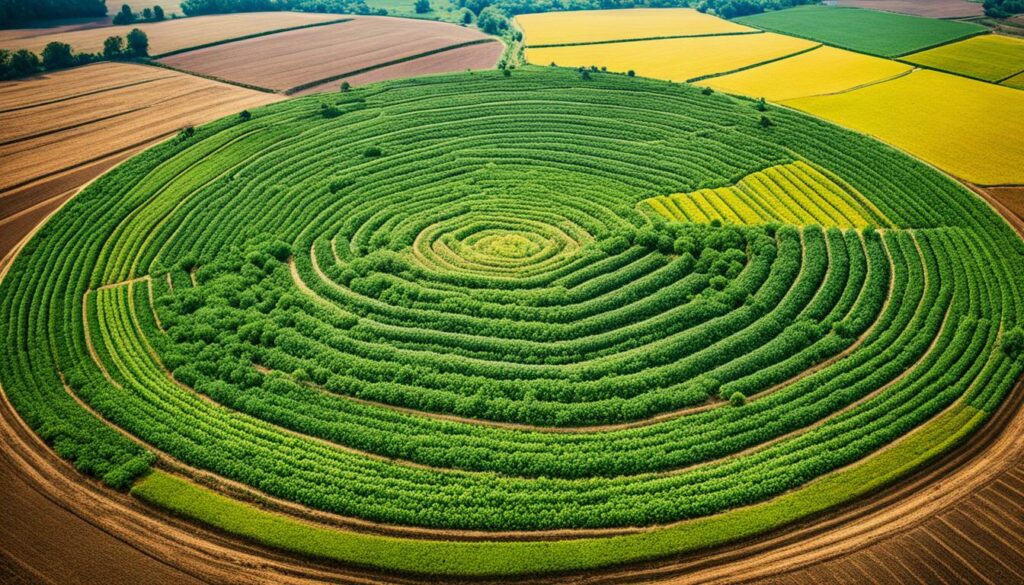
Moreover, carbon farming creates business chances and helps reach zero net emissions. Those involved can earn Australian Carbon Credit Units (ACCUs) for storing or cutting emissions. These credits can be sold to boost farm income sharply.
A fascinating part of carbon farming is the carbon farming network it creates. This network includes projects like the Emissions Reduction Fund (ERF) and the Reef Credit scheme. It gives farmers different ways to earn money from their land, supported by groups like the Carbon Market Institute.
It’s significant that carbon farming could stop crop yield drops of up to 30% by 2050. It does this by using resources better and improving farm output. Besides environmental benefits, it secures farm profits. HeavyFinance’s Green Loans at 0% also help, making it a good choice for modern farming.
| Benefits | Details |
|---|---|
| Ecosystem Services | Water provision, biodiversity, and farm resilience |
| Financial Gains | Earning ACCUs, diverse income streams |
| Climate Adaptation | Mitigating yield reductions, optimising resources |
| Networking | Joining various carbon farming programs and markets |
In summary, the benefits and incentives of carbon farming make it vital for today’s and tomorrow’s agriculture. It ensures big gains for farmers in both the environment and the economy.
The carbon cycle is vital for farmland. Solar energy is key, helping plants grow. They take in CO2 and turn it into biomass. This part, photosynthesis, uses solar energy and is key for a healthy farm.
Solar energy drives the carbon cycle by helping plants grow. These plants use photosynthesis to change CO2 to organic matter. This matter supports plants and powers many farm processes. Using solar energy in farming is crucial for better carbon practices.
Carbon sequestration is key in carbon farming. It traps carbon from the air in plants and soil organic matter. The Natural Resource Conservation Service (NRCS) says this process boosts soil health while cutting down gas emissions. It helps more carbon stay in the soil.
The Carbon Cycle Institute (CCI) leads in creating models that focus on carbon for land care. This way has won backing from various natural resource groups. Successful carbon farming boosts carbon storage, helping fight climate change.
It’s crucial to see how carbon flows in ecosystems. Tapping into solar energy for farming and storing carbon in the soil makes agriculture stronger and safer.
Soil health is key to keeping our farms sustainable. The health of soil relies on its organic matter. This matter helps keep the soil’s shape, holds water, and recycles nutrients.

Healthy soil is full of organic matter. This acts as a store for nutrients and powers soil processes. Adding carbon to the soil through methods like cover crops helps the earth in many ways. It lessens climate change, boosts fertility, and makes soil strong.
“Healthy soil is the foundation of a healthy ecosystem and a sustainable agricultural practice.”
More soil carbon brings lots of benefits. It cuts down erosion and nutrient loss. It holds more water and helps good microbes thrive, making farming better.
Nutrient cycling in farming is all about soil organic matter. It’s about how microbes provide plants with needed nutrients. This vital process reduces the need for harsh fertilisers and lessens runoff.
We need to help farmers improve their soil health. This means teaching them about raising soil carbon. It makes farms tougher, helps water use, and encourages sustainable farming.
| Benefits of Increased Soil Organic Carbon | Impact |
|---|---|
| Enhanced Soil Structure | Improved Water-holding Capacity |
| Reduced Erosion and Nutrient Loss | Greater Soil Stability |
| Increased Microbial Activity | Efficient Nutrient Cycling |
| Better Water Use Efficiency | Buffering Against Drought Stress |
| Mitigated Greenhouse Gas Emissions | Growth of Beneficial Soil Microorganisms |
| Higher Agricultural Resilience | Improved Crop Yields and Quality |
Looking after our soil well matters a lot. It helps keep the soil healthy. This makes sure there’s enough soil carbon. So, the soil can keep growing our food and look after the planet.
Keeping soil carbon levels high is key to healthy soil and good crops. Soil carbon helps keep water, nutrients, and the soil itself. Also, it helps fight climate change by lowering carbon dioxide in the air.
Different types of farming methods can help reach these aims. For instance, cutting down how much we plough and putting old plant parts back into the soil works well. Adding things like manure, compost, or cover crops helps, too. Perennial plants, which live for many years, are great for the soil. They grab lots of carbon and stop the soil from washing away.
But, it takes a long time to increase soil carbon a lot. It can take decades. But, if we plough too much, we can lose these good changes in just a few years.
Let’s look at some numbers on why caring for our soil is so important:
| Practice | Benefit |
|---|---|
| Reducing tillage | Increases soil carbon storage and improves soil health |
| Adding crop residues | Boosts profitability and reduces greenhouse gas emissions |
| Using cover crops | Enhances total yield and sequesters soil carbon efficiently |
| Converting to perennial crops | Reduces erosion and lowers greenhouse gas emissions |
Taking care of the soil the right way is about more than just keeping carbon in. It helps us keep making food for the long run. By using these methods, farmers can make their soil better. This leads to more food, and it helps fight climate change, too. It’s about building an agriculture that lasts for our kids and their kids after that.
Cutting down on greenhouse gases in farming is key to fighting climate change and supporting sustainable farming practices. Farming, especially through methane and nitrous oxide, is a major source of these gases. This was particularly noticeable in the U.S. in 2007. It showed how important it is to take action.
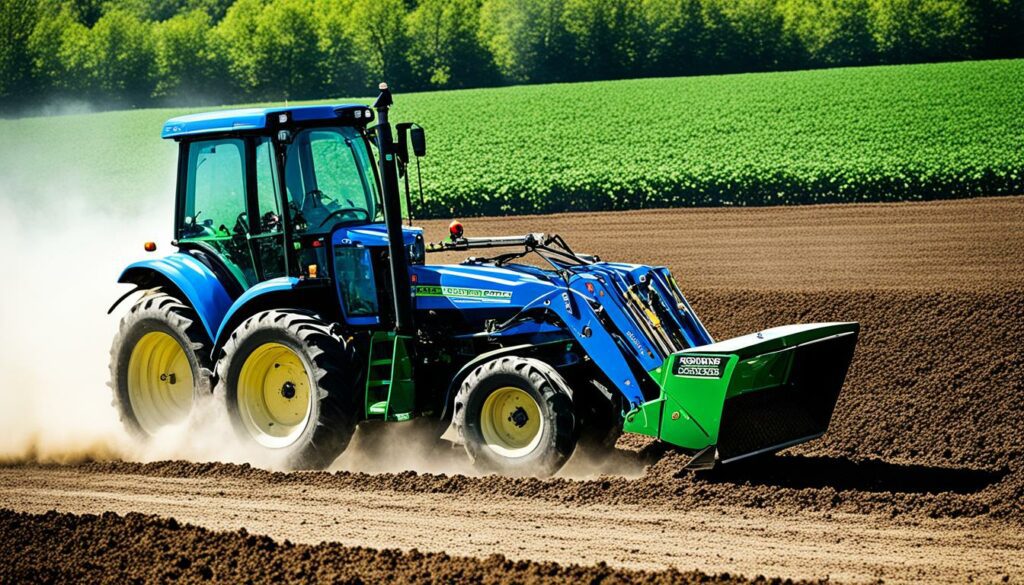
We must focus on lowering methane from livestock and dairy farms. This comes mainly from the guts of cows and when manure breaks down. Farmers can lower these gases by changing what they feed their animals. This includes special additives. Another helpful method is using anaerobic digesters. They collect methane from manure and turn it into biogas, a clean energy source.
For nitrous oxide, it’s all about how we manage nutrients. Farmers can cut these emissions by being smarter with how and when they use nitrogen. For example, through using fertilisers that release their nutrients slowly or with chemicals that stop nitrogen turning into nitrous oxide. More high-tech approaches like using drones for farming can help manage fertilisers better.
To wrap up, it’s vital to tackle methane and nitrous oxide in farming. Doing so helps fight against not only these specific greenhouse gases but also climate change in general. It’s a smart step forward for making sure agriculture is kinder to the planet.
| Approach | Action | Impact |
|---|---|---|
| Methane Emission Reduction | Alter livestock feeds, use anaerobic digesters | Reduces methane gases, generates renewable energy |
| Nitrous Oxide Mitigation | Optimise nitrogen fertiliser use, drone-based monitoring | Minimises N2O emissions, improves fertiliser efficiency |
In carbon farming, many methods boost carbon capture in the farming environment. The NRCS recognises thirty-five practices essential for this. These range from cover cropping to efficient grazing that help store carbon. This improves the health and strength of farms.
Their effect is huge. Over history, farm soils lost 70% of their organic carbon. This released 133 billion metric tons of CO2 in 12,000 years. But, with these methods, we can aim to cut 5.3 GtCO2 emissions yearly by 2030.
Besides just storing carbon, these methods boost plant cover and use of manure. They also improve soil, helping it hold water better and fostering more life. This makes our farmlands better at storing carbon.
Support for carbon farming is growing. The Carbon Cycle Institute’s approach has won over many levels of government. It shows the chance for a change to farming that’s good for the planet and our pockets.
Using these methods is key for strong farms and less pollution. Secretary Vilsack’s recent news highlights the need for solid policies. These encourage farmers to join in. There’s also the Growing Climate Solutions Act, helping farmers earn from their green efforts.
To sum up, choosing the right carbon farming methods is crucial for big carbon gains in farming. By using these carbon sequestration methods, farmers can meet their targets. This leads to farms that last and thrive for the future.
Climate-smart agriculture (CSA) is a new way to face climate change in farming. It blends new farming methods with tech. This mix aims to make farming better suited to handle climate change worldwide.
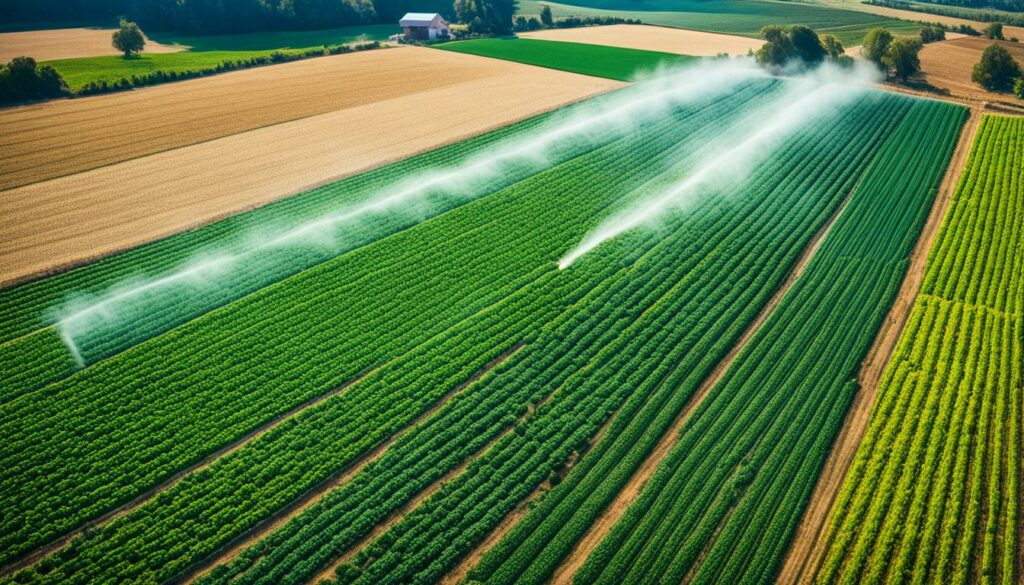
Today, farming is changing to be more about preserving the planet and being efficient. For example, using compost and biochar greatly improves the quality of soil. This helps soil hold water and withstand extreme weather.
Then there’s precision farming. It makes sure we use water and fertilisers in the best way. This cuts down waste and is better for the environment.
Tech is key to making agriculture smarter for the climate. This includes tools like precision farming and data-based systems. They help farmers make smarter choices.
These tech not only make farming more efficient. They also help cut the carbon footprint of farming. Tools that measure a farm’s carbon emissions are part of this. They make it easier to use practices that are kinder to our planet.
“Adopting climate-smart agricultural practices is key to long-term farm sustainability. This is especially important as we try to feed a growing global population that could hit 9.7 billion by 2050.”
The World Bank is putting more money into making farming climate-smart. This includes helping countries like Bangladesh, Ghana, and Kenya. Strong support, like a loan reducing China’s emissions and a program in Africa, shows the importance of technology in making farming strong for the future.
Crop rotations are key for sustainable farming. They help crop diversity in farming by alternating crops. This method improves soil health improvements a lot.
Changing crops prevents soil from losing all its nutrients. For example, planting corn after beans for two years boosts corn yield by 29%. With legumes and a four-year cycle, yield could increase by 48%.
Using crop rotations can greatly cut down on pests. If you grow the same plant all the time, pests build up. But changing crops stops these pests from growing. It also helps the soil keep its nutrients and structure, reducing problems like compaction.
Studies show that farmers make more money and have better crops after using rotations. Not only that, but it also cuts down on pollution. 60% of eroded soil from the Midwest ends up in our water. Crop rotations, especially with cover crops, stop the topsoil from being washed or blown away. This keeps the land productive and healthy.
| Rotation Cycle | Yield Increase | Benefits |
|---|---|---|
| Two-year | 29% | Better yields, nutrient replenishment |
| Four-year with legume cover | 48% | Higher yields, reduced input costs, soil health improvement |
To sum up, crop rotations are vital for good farming. They don’t just help the farm – they help the environment too. They make the soil better, manage pests, and use nutrients well. This makes the whole farming system strong and long-lasting.
Handling tillage to lessen soil shaking is crucial for eco-friendly farming. It aims to cut the amount of carbon farming leaves behind. One top method is conservation tillage. It keeps 30% of the crop waste on the ground. This keeps the soil healthy.

In 2010-2011, 40% of crop lands in the USA used gentle tilling practices. These methods, like no-till, are spreading fast. They reduce the release of CO2. This is good for the environment.
A study in Nebraska showed that tillage affects CO2 release in different ways. While it doesn’t change the total CO2 much, it can impact CO2 release during the year. Summer tillage increases CO2 emission due to hot soil.
Conservation tillage doesn’t just help the environment. It makes the soil better. It stops soil from washing away and helps it hold water. This is good for crops. These practices also trap carbon in the soil, which fights climate change.
In dry areas, like some parts of the world, farmers use soil-saving methods more. This helps them stand up to climate changes and keeps their land fertile. Conservation tillage lowers the need for fuel and work, making it good for the planet and the pocket.
Practices like no-till farming make farms stronger. They emit less greenhouse gases. This helps meet goals to reduce carbon from farming. It makes farming better for the earth.
Good manure management helps in sustainable farming by reducing greenhouse gases. It also improves the nutrient cycle. Around 10% of the world’s GHG livestock emissions come from managing manure. This is mainly from nitrous oxide and methane. Using manure efficiently and sustainably is key to better farming.
Applying manure well boosts crop growth and cuts down on lost nutrients. Using the ‘4Rs’ helps: choose the right manure, use the right amount, apply it at the right time, and put it in the right place. This method makes sure manure helps crops without harming the environment.
Turning farm waste into biogas is a smart way to handle manure. Biogas is a green energy and lowers methane. In Rwanda, flexibiogas technology has made a big difference. It needs less manure and cuts down on greenhouse gases. This also means less smoke from burning wood, which is good for health.
Manure management is getting better with new tech like biogas and digesters. These tools help deal with waste and improve nutrients in farming. They make farming both sustainable and productive.
Farming faces many challenges like tech costs and different types of manure. But using manure well and making biogas can lower greenhouse gas emissions. It also boosts the soil. This shows that good manure management is very important in today’s farming.
When talking about renewable energy in agriculture, it’s key to see the benefits of investing. The USDA leads in this, giving $207 million for renewable energy and fertilizer projects. This helps U.S. farmers by supporting their work.
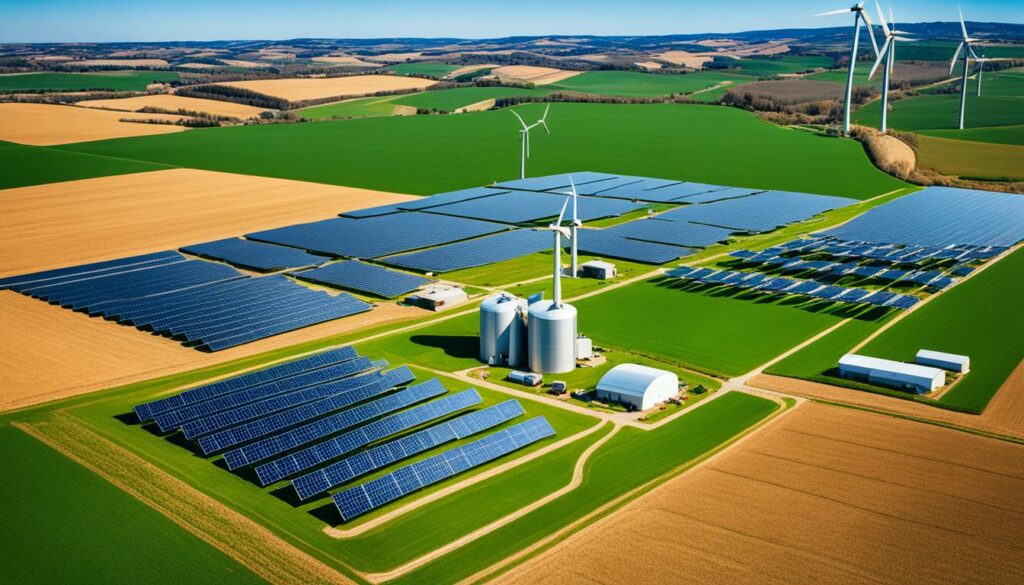
The USDA supports the Rural Energy for America Program (REAP) with $157 million. It helps farmers in 42 states by letting them use solar, wind, and biogas. This cuts emissions from their farms. The Inflation Reduction Act shows the government’s strong push for sustainability with over $94 million for REAP.
These payments help not just the planet but the farmers’ pockets too. With the Investment Tax Credit, farmers can lower their taxes by up to 30%. This means they can get solar panels without big costs.
The USDA’s initiatives have invested over $1.6 billion through REAP since the starting of the Biden-Harris Administration, advancing 5,457 renewable energy and energy efficiency improvements.
The effort goes further than REAP. The Fertilizer Production Expansion Program (FPEP) got $50 million, helping seven states to grow. Another $166 million went to 40 projects across the nation. This aims to lower fertilizer costs and help the environment by cutting carbon.
| Program | Investment | Projects | States |
|---|---|---|---|
| REAP | $157 million | 675 | 42 |
| FPEP | $50 million | 7 | 7 |
| Overall USDA Investments | $1.6 billion | 5,457 | Nationwide |
Supporting these programmes helps us see the importance of renewable energy in agriculture. It stresses the need for sustainable energy solutions in farming. This is vital for a greener and less polluting future in farming. By using more renewable energy, we can cut down majorly on harmful emissions.
Using fertilisers well is essential for good farming and the planet. The right use can boost crop growth and limit harm to the environment. Nowadays, new fertiliser methods are helping do this better. They make sure crops get what they need, cut waste, and lower pollution.
Controlled release fertilisers are a big step forward in taking care of soil. They let out nutrients slowly, which suits the plants as they grow. This slow release helps keep the nutrients where they’re needed. It means crops use more of what they get, and we waste less.
Precise ways of feeding plants, like precision fertigation, are changing farming. With this, nutrients go straight to the roots through water systems. Not only does it help plants use more nutrients, but it’s also better for the Earth. These methods are important for making sure farming helps the planet while growing good crops.
Using modern fertilisers wisely is vital for today’s farms. It helps crops grow better and keeps our planet safe. This new way of farming is key to feeding people and protecting our environment.
Carbon management involves methods that boost CO2 capture on farms. It helps remove CO2 from the air. This process is crucial for making the land more fertile and productive.
Carbon farming uses techniques to store carbon in soil and plants. This cuts down on carbon in the air from farming. It’s a key ally in fighting climate change and keeping our planet healthy.
Carbon farming isn’t just about storing carbon. It also helps by improving the land’s water usage and bringing back diverse plant and animal life. This makes farms stronger against the changing climate.
It also supports the growth of sustainable food networks and helps companies be more environmentally friendly.
Solar power is essential for plant growth. Plants turn CO2 into material that stores carbon. This stored carbon helps keep the soil healthy and supports the life in each ecosystem.
Soil health is vital because it acts as a storage place for carbon. It also needs to be rich in nutrients to support plants and animals. Healthy soil makes farms more productive and better at handling changes in the environment.
Sustainability means caring for the soil so it can trap carbon well. This involves keeping the soil as natural as possible and making sure it holds onto water and nutrients. These steps are crucial for a healthy soil and good carbon storage.
Farmers can reduce harmful gases by being careful with what their animals eat and how they manage their waste. They can also limit certain gas releases by using fertilisers wisely.
To store carbon, farmers can plant more, manage leftover plants better, control how their animals graze, and use manure smartly. These actions effectively lock away carbon in the ground and in plants.
Climate-smart farming uses new ways and technologies to adapt to the changing climate. It includes using modern tools and methods that use resources better and leave a smaller carbon footprint.
Rotating crops stops pests and diseases from taking hold. It also makes the soil richer in nutrients. This farming method helps keep the soil strong and full of life.
By disturbing the soil less, conservation tillage keeps its life and nutrients locked in. This way, the soil can store more carbon and stays healthy. It’s a smart choice for keeping land productive and in good shape.
Dealing with manure well, following nutrient guidelines, and turning it into biogas, stops waste and harmful gases. It also gives the soil back what plants need to grow. This approach is good for the farm’s health and caring for the environment.
Putting money into renewable power cuts emissions and saves money for farmers. It makes farming friendlier to the planet and ready for the future.
These fertilisers let out nutrients slowly as plants need them. This makes farming more efficient and less wasteful. It’s a modern way to farm that’s better for the economy and the earth.